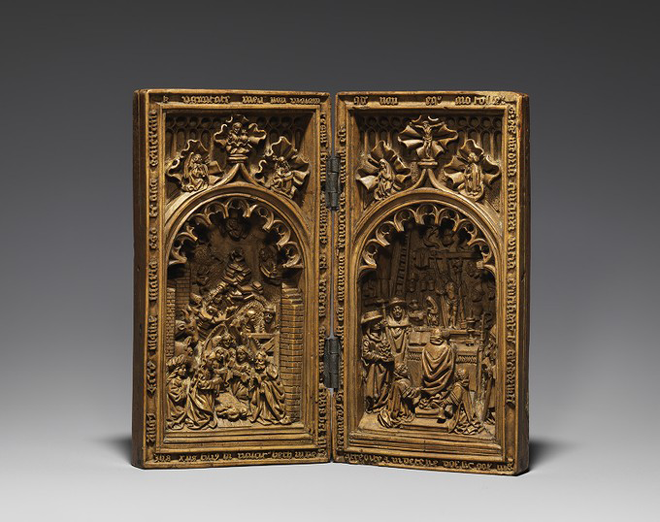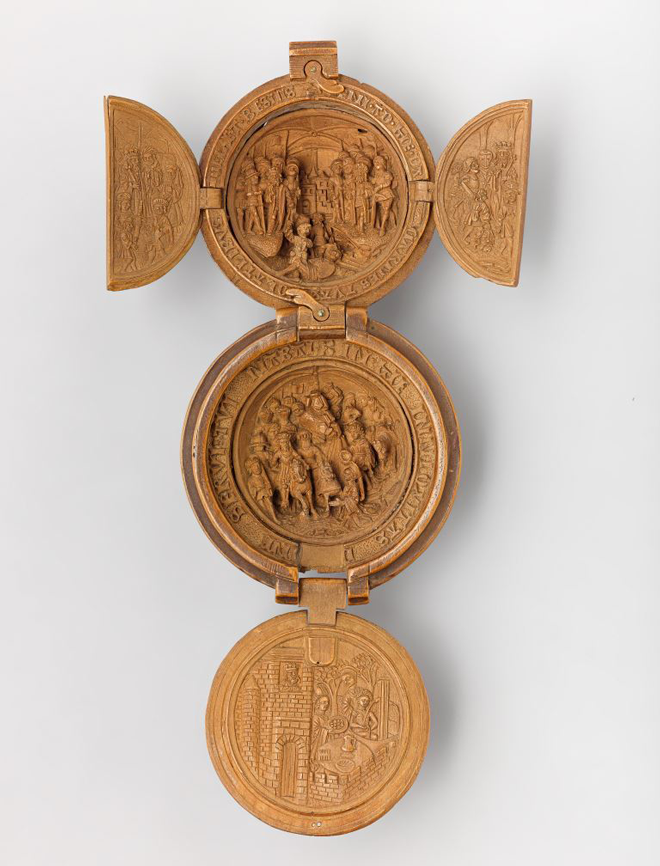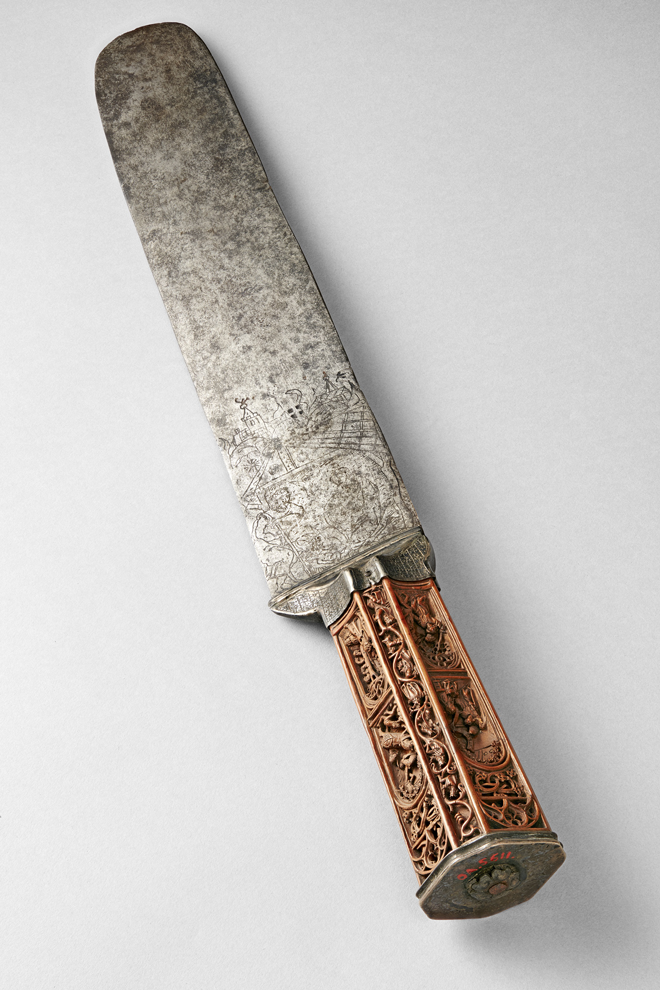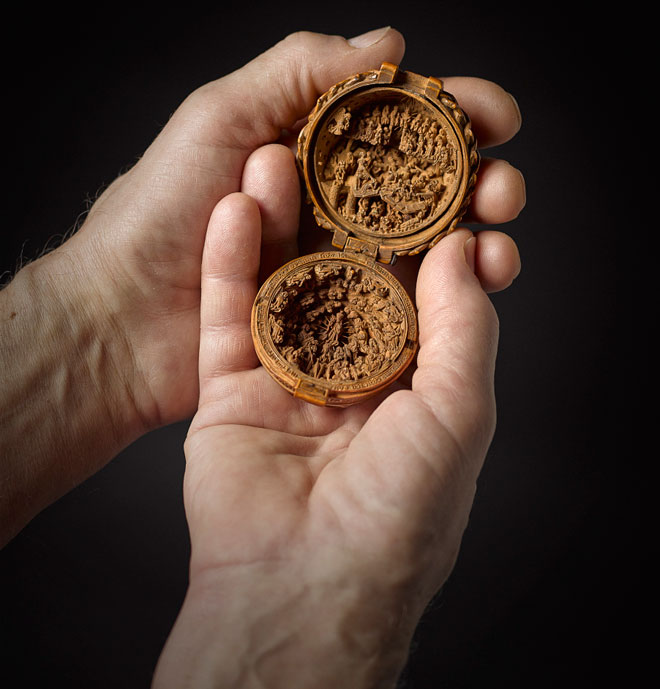Why do miniatures provide such singular pleasure?
They certainly make you feel a little bit like a god. And there’s a nostalgic element that recalls childhoods spent with small dollhouses and accessories. But the Art Gallery of Ontario’s new showing of Gothic boxwood miniatures provides another, perhaps more convincing, merit: museum-quality miniatures are intricate to the point of impracticality. In an era of life hacks, there is no luxury greater than an unnecessary expenditure of energy.
“Small Wonders: Miniature Boxwood Miniatures” brings together more than 60 rare boxwood carvings (a substantial portion of the world’s inventory), which were made in one or two workshops in Northern Europe during the early 1500s. This was a unique moment: it was late enough that a merchant class with disposable income had emerged, but early enough that the Reformation and Counter-Reformation hadn’t wholly dissuaded consumers from luxurious religious trappings. The resulting objects are spectacularly detailed—so much so that the AGO and its partner institutions, the Met Cloisters in New York and the Rijksmuseum in Amsterdam, had to involve micro-CT scanning to properly understand the full intricacies of these objects, whose details are often invisible to the naked eye.
Their craftsmanship is so impressive contemporary studies struggle to account for them. Building on such a tiny scale is theoretically possible, but how was this level of craftsmanship achieved, especially 600 years ago? They are a little like Stonehenge, but palm-sized and thankfully free of crackpot alien theories.
And, compounding the value of these objects in and of themselves, they have passed through the hands of some impressive historical figures. It is generally a poor decision to assume that someone else’s interest in an object merits your own, but these micro-carvings have enough to recommend them. An interesting provenance is just a useful organizational tool.
Here, a few examples of examples of exceptional taste.
 South Netherlandish, Rosary, 1509–26. Boxwood. Overall (length, diameter): 472 mm × 57 mm. Devonshire Collection, Chatsworth. Reproduced by permission of Chatsworth Settlement Trustees. Photo: Craig Boyko/Ian Lefebvre © Art Gallery of Ontario, 2016.
South Netherlandish, Rosary, 1509–26. Boxwood. Overall (length, diameter): 472 mm × 57 mm. Devonshire Collection, Chatsworth. Reproduced by permission of Chatsworth Settlement Trustees. Photo: Craig Boyko/Ian Lefebvre © Art Gallery of Ontario, 2016.
1. Henry VIII’s Decade Rosary
This rosary belonged to Henry VIII and his first wife Catherine of Aragon, and, despite being a fascinating object, it didn’t make quite the impression it should have, as Henry banned the use of rosaries altogether in 1534. Consisting of 11 beads, the decade rosary offers prayer prompts. Buried behind a sculpted pillar within the largest bead are two figures, likely images of Henry and Catherine, observing a church service.
Odds are Catherine kept the rosary in the divorce. But the rosary also had another famous owner: the Duke and Duchess of Devonshire, she of the famous Mitford clan, bought the rosary for their collection at Chatsworth House in England.
 South Netherlandish, Miniature Altarpiece, Nativity; Mass of St. Gregory, 1490–1510. Boxwood. The Metropolitan Museum of Art, Gift of J. Pierpont Morgan, 1917. MMA photography by Peter Zeray, Imaging, The Metropolitan Museum of Art, Image © The Metropolitan Museum of Art.
South Netherlandish, Miniature Altarpiece, Nativity; Mass of St. Gregory, 1490–1510. Boxwood. The Metropolitan Museum of Art, Gift of J. Pierpont Morgan, 1917. MMA photography by Peter Zeray, Imaging, The Metropolitan Museum of Art, Image © The Metropolitan Museum of Art.
2. Queen Christina of Spain’s Miniature Altarpiece
Though Queen of Spain from 1879 to 1902, Maria Christina was a member of the Austrian Habsburg-Lorraine house—a long line of micro-carving fans. As Frits Scholten notes in the Rijksmuseum’s exhibition catalogue, “Dircksz’s most expensive products were ordered by the Habsburg court and members of its entourage.”
This miniature altarpiece, which depicts the nativity and the mass of St. Gregory (during which Christ appeared in the church after Pope Gregory I made an appeal), is “a cornerstone of the Morgan medieval collection at The Met,” according to the Rijksmuseum’s exhibition catalogue. Larger-than-life American financier J. Pierpoint Morgan purchased the altarpiece from Charles Mannheim in 1898 for the Met.
 Netherlands, Prayer Bead (David and Goliath), 1500–30. Boxwood with metal fittings. Overall closed: 47.1 mm x 55.1 mm. The Thomson Collection © Art Gallery of Ontario. Photo: Craig Boyko/Ian Lefebvre © Art Gallery of Ontario, 2016.
Netherlands, Prayer Bead (David and Goliath), 1500–30. Boxwood with metal fittings. Overall closed: 47.1 mm x 55.1 mm. The Thomson Collection © Art Gallery of Ontario. Photo: Craig Boyko/Ian Lefebvre © Art Gallery of Ontario, 2016.
3. Frédéric Spitzer’s Prayer Bead
Vienna-born Frédéric Spitzer was a voracious collector. Born in 1815 to (it is thought) a grave-digger, Spitzer entered the army, before making his first acquisition—an engraving by Albrecht Dürer (certainly one way to kickstart a collection). He sold it at a profit, and his fate as a dealer was settled. He moved to Paris in 1852 and became one of the most renowned dealers of art and antiquities in Europe, although he was not necessarily the most transparent.
Reports about shady dealings, specifically forgeries created by Spitzer’s restorer Reinhold Vasters, abound. As the AGO’s exhibition catalogue notes, “Over one hundred of the surviving gothic boxwood carvings surfaced in nineteenth-century Paris.” This prayer bead is not the only object in the show that passed through Spitzer’s hands. Also among them: a miniature altarpiece that depicts the carrying of the cross, which had its triptych wings rather unceremoniously removed by Spitzer to make it more attractive at market.
 Flemish, Knife, early 16th century. Wood, steel, silver with leather case. Handle: 43.8mm × 35mm × 110.9 mm. Knife: 57.4 mm × 35 mm × 445 mm. Paris, Louvre Museum, department of decorative arts. Photo: Craig Boyko/Ian Lefebvre © Art Gallery of Ontario, 2016.
Flemish, Knife, early 16th century. Wood, steel, silver with leather case. Handle: 43.8mm × 35mm × 110.9 mm. Knife: 57.4 mm × 35 mm × 445 mm. Paris, Louvre Museum, department of decorative arts. Photo: Craig Boyko/Ian Lefebvre © Art Gallery of Ontario, 2016.
4. Baron Adolphe de Rothschild’s Knife with Biblical Scenes
Funnily enough, yet another Spitzer connection works its way in here. Chatting about his client Sir Richard Wallace, Spitzer boasted “he sold over 60,000,000 francs worth of art to the English collector and to Baron Adolphe Carl von Rothschild (1823-1900) alone,” says theRijksmuseum’s catalogue. Rothschild ascribed to the Kunstkammer-school of collecting, and his 1901 bequest to the Louvre means that the institution now holds one of the most robust collections of these objects.
This knife, attributed to the Adam Dircksz workshop, was obviously not intended as a weapon. The Rijksmuseum’s catalogue suggests that this knife handle along with a second similar one “may have been occasional pieces that belonged to a set, for they have the same Middle Dutch inscription: ‘Blyt is sonder verganc, Ghetrov min leven lanc’ (‘Happiness is without end, faithfulness my whole life long’).”
5. Unknown’s Peapod
The original owner of this sculpture is unknown, which is a real shame because their taste was superlative. Dircksz’s workshop has managed to squeeze two particularly raunchy religious scenes—Joseph with Potiphar’s wife on the left, and goddesses Aphrodite, Hera and Athena waiting, naked, to be judged by Paris—into, inexplicably, a peapod.
“Both scenes reflect the growing fascination with eroticism in early sixteenth-century northern art, which manifested itself in the depiction of the sensual female nude in all kinds of mythological scenes and statuettes,” says the Rijksmuseum’s catalogue. This seems familiar enough—there are plenty of art-historical parallels—but why a peapod? “The choice of the legume form is puzzling, and may have something to do with the symbolism of a few fifteenth-century miniatures that has itself not yet been adequately unravelled,” notes the catalogue. In other words, who knows? But this tiny object perfectly blends oddity and scandal in a fashion that more artists should try to emulate.

 Adam Dirksz, Prayer Bead, 1500–30. Boxwood with metal fittings. Overall Closed: 58.8mm × 61.1mm. Overall Open: 56.5mm × 56.5mm × 116.3mm. The Thomson Collection © Art Gallery of Ontario. Photo: Craig Boyko/Ian Lefebvre © Art Gallery of Ontario, 2016.
Adam Dirksz, Prayer Bead, 1500–30. Boxwood with metal fittings. Overall Closed: 58.8mm × 61.1mm. Overall Open: 56.5mm × 56.5mm × 116.3mm. The Thomson Collection © Art Gallery of Ontario. Photo: Craig Boyko/Ian Lefebvre © Art Gallery of Ontario, 2016.







